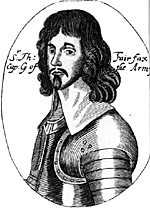
The Royalists in Sherburn had a guard of 20 or 30 horse out to give warning of any attack. Having got as close as possible unobserved, Fairfax tells us that he suggested to Hotham that "If he would second me I would charge those horse, and if they fled, I would pursue them so close as to get into the town with them. He promised to second me. I went to the head of my trooos and presently charged them: who fled, and we pursued them close to the barricado."
So far so good, literally a text book attack. But it is an old military maxim that no plan lasts longer than first contact with the enemy. In Fairfax's own words "But they got in, and shut it (that is, the barricado) upon us; where my horse was shot at the breast. We filled the lane; being strait, that we could not retreat without confusion and danger of their falling in our rear.
Such is the difference between theory and practice! Fortunately for Fairfax there was a gap in the barricade. They were able to force an entry and once in to follow Cruso's instructions to prevent the enemy resisting the attack; "Send some horse to run through the streets to keep the soldiers in; and to hinder them from mountinq on horseback."
Fairfax wrote "we entered the town, which soon cleared the streets, and pursued those that fled." At this point his horse dropped dead. Having achieved their objective and with Royalist reinforcements approaching, Fairfax and Hotham made good their escape. He had been lucky! [32]
Sir Thomas' next significant action was the storming of
Leeds. No mere raid, this. A two pronged attack was launched
against a forewarned enemy in prepared positions with cannon. A
strong resistance was overcome when defenders were driven from a
breastwork by musketry, allowing Fairfax's men to enter the town.
Once the cavalry was able to enter all resistance ended quickly. As
with the defence of the bridge at Tadcaster the capture of Leeds was
primarily an infantry affair and whilst Sir Thomas commanded
overall, the various assaults by the infantry were led by infantry
officers, not Sir Thomas. Indeed, it has to be said that the
contemporary accounts give the impression that beyond deciding to
launch a two-pronged attack, Fairfax had no particular plan for
overcoming the Royalists defences.
The main breakthrough seems to have come after a display of
initiative by half-a-dozen musketeers who got themselves into a
position to enfilade a Royalist position, drive off it's defenders and
open up an entrance for infantry led by Major Forbes. Of Fairfax
himself an account tells how he "gave charged and commanded,
and, riding from place to place, encouraged them to fall on
resolutely." [33]
More Fairfax
Sir Thomas Fairfax: Introduction
Sir Thomas Fairfax: Wetherby
Sir Thomas Fairfax: Sherburn
Sir Thomas Fairfax: Seacroft Moor and Wakefield
Sir Thomas Fairfax: Adwalton and Hull
Sir Thomas Fairfax: Winceby and Nantwich and Marston Moor
Sir Thomas Fairfax: Conclusion and Notes
Back to English Civil War Times No. 54 Table of Contents
Back to English Civil War Times List of Issues
Back to Master Magazine List
© Copyright 1998 by Partizan Press
This article appears in MagWeb (Magazine Web) on the Internet World Wide Web.
Other military history articles and gaming articles are available at http://www.magweb.com